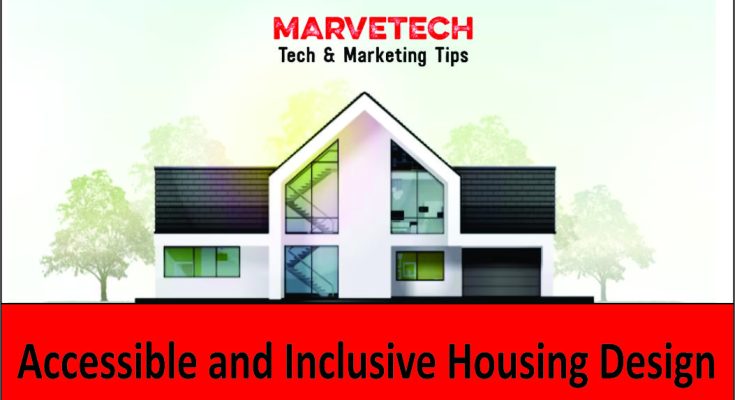Accessible and Inclusive housing design refers to the intentional and thoughtful approach of creating living spaces that are open and accommodating to people of all abilities. This design philosophy prioritizes the removal of physical, sensory, and cognitive barriers, ensuring that individuals with disabilities can navigate and utilize their homes independently and comfortably. By incorporating universal design principles, such as wider doorways, grab bars, and accessible features, this approach aims to promote equal opportunities and create living environments that foster inclusivity, dignity, and a higher quality of life for all residents.
Introduction
Accessible and Inclusive Housing Design is a philosophy and practice that aims to eliminate barriers and create living spaces that are welcoming, functional, and accommodating for people of all abilities. It emphasizes the importance of universal design principles, incorporating features that promote independence, safety, and comfort, ultimately fostering inclusivity and enhancing the quality of life for everyone.
The concept of accessible and inclusive housing design goes beyond mere compliance with building codes. It embraces the idea that everyone, regardless of their physical abilities or age, should have the opportunity to live in a home that accommodates their needs and fosters independence.
Importance of Accessible and Inclusive Housing Design
1. Enhancing Quality of Life
Accessible and inclusive housing design directly impacts the quality of life for individuals with disabilities, seniors, and those with mobility challenges. By incorporating universal design principles, homes can be made more user-friendly and adaptable, allowing residents to move around independently, perform daily tasks, and participate fully in their communities.
2. Aging in Place
With an aging population, designing homes that support aging in place has become crucial. Accessible features, such as wider doorways, grab bars, non-slip flooring, and lever-style door handles, enable older adults to remain in their homes comfortably and safely as they age, reducing the need for institutional care.
3. Inclusion and Equality
Accessible and inclusive housing design promotes social inclusion and equal opportunities for individuals with disabilities. It eliminates barriers and ensures that everyone can fully participate in family life, social activities, and community engagement.
Key Considerations for Accessible and Inclusive Housing Design
1. Universal Design Principles
Universal design principles aim to create products, environments, and systems that are accessible and usable by people of diverse abilities, ages, and backgrounds. These principles promote inclusivity, independence, and equal participation for all individuals.
Key aspects of universal design include flexibility, simplicity, intuitive use, and equitable access. By implementing universal design principles, spaces, and products can accommodate a wide range of users, including those with disabilities or mobility challenges, older adults, and individuals with temporary impairments. The universal design promotes a more inclusive and barrier-free society, fostering independence, dignity, and equal opportunities for everyone.
2. Accessibility in Design Elements
Accessibility in design elements is crucial for creating environments that can be used by individuals of all abilities. It involves incorporating features and considerations that remove barriers and facilitate easy access and use. This includes elements such as ramps, wider doorways, grab bars, tactile indicators, adjustable height countertops, and accessible bathroom fixtures.
By integrating accessibility into design elements, spaces become more inclusive, enabling individuals with disabilities or mobility challenges to navigate and utilize them independently and safely. It promotes equality, dignity, and independence for all users, regardless of their physical abilities or limitations.
3. Ample Lighting and Contrast
Ample lighting and contrast are essential considerations in design to enhance accessibility and inclusivity. Sufficient lighting ensures that spaces are well illuminated, promoting safety, visibility, and ease of navigation for individuals with visual impairments or reduced visibility. It helps prevent accidents and promotes a sense of comfort and security.
Contrast, on the other hand, refers to the difference in color or brightness between objects or surfaces. Using appropriate contrast, such as contrasting colors for walls, floors, furniture, and signage, aids individuals with visual impairments in distinguishing between elements and navigating their surroundings effectively.
By incorporating ample lighting and contrast, design elements become more accessible and usable for people of all abilities, promoting inclusivity and ensuring equal access to information and spaces.
4. Safety Features
Safety features are crucial elements in design that prioritize the well-being and security of individuals. In various settings, safety features play a vital role in mitigating potential hazards and ensuring a secure environment.
These features can include fire detection and suppression systems, emergency exits, handrails, non slip flooring, and appropriate signage. By incorporating safety features, design spaces become more resilient to accidents, promoting the physical safety and peace of mind of occupants. Safety features are especially important in public spaces, workplaces, and homes, where they contribute to creating an environment that prioritizes the protection and welfare of individuals.
5. Outdoor Accessibility
Outdoor accessibility is a critical aspect of creating inclusive environments that are accessible to individuals of all abilities. Designing outdoor spaces with accessibility in mind involves considerations such as the inclusion of ramps, paved pathways, curb cuts, and handrails to ensure smooth and barrier-free movement for individuals with mobility aids or disabilities.
Additionally, accessible outdoor spaces may include amenities such as accessible seating areas, wheelchair-friendly picnic tables, and recreational facilities designed to accommodate various physical abilities.
By prioritizing outdoor accessibility, we create inclusive environments that allow everyone to enjoy and engage with nature, parks, public spaces, and recreational activities, fostering equal opportunities for outdoor participation and social interaction.
6. Collaboration with Professionals
Collaborating with professionals is a crucial step in achieving effective and inclusive design. Engaging architects, designers, accessibility experts, and other professionals who specialize in inclusive design ensures that the needs of individuals with disabilities or specific requirements are properly addressed.
These experts bring specialized knowledge, expertise, and insights that help navigate complex regulations and guidelines related to accessibility. By involving professionals in the design process, the result is a more informed and comprehensive approach to creating inclusive spaces that meet diverse needs.
Collaborative efforts with professionals promote the integration of best practices and innovative solutions, ultimately leading to the development of spaces that are truly accessible, functional, and welcoming for all individuals.
Conclusion
To sum up, Accessible and Inclusive Housing Design aims to create homes that are welcoming, remove obstacles, and improve the lives of people with different abilities. It seeks to build a more inclusive and caring society.
Accessible and inclusive housing design is a crucial aspect of creating homes that embrace diversity, promote independence, and foster inclusion. By incorporating universal design principles, considering the specific needs of individuals with disabilities and seniors, and collaborating with experts in the field, we can transform living spaces into inclusive environments that accommodate all residents.




